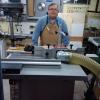I'm using a sawstop 3hp (the one before there was a contractor saw). I'm ripping home depot 2x10s and 2x12s. I have the riving knife and kick back pawls installed. All boards sat in my shop for two+ weeks.
Boards are jointed and planed one side. I've had a few warp while being cut that I have stopped and then hand cut. Question on that in a bit...
This last board was pinching together and pushing the board back at me. I stopped and took a look, but the pinch doesn't seem overly strong compared to some of the others I've watched do interesting things.
What's the best technique during the cut for safety when this occurs? Just stop the saw and remove the board? The temptation to power thru it is strong, but I've heard the saw sound change a few times on this lumber and have just stopped the cut to be safe.
I don't buy much framing lumber and while I have worked with it before, I havent really experienced this strong of behavior before. Is this a technique issue that just hasn't exposed itself while cutting dryer wood? Maybe I screwed up my fence alignment and did not realize it? Most of it has cut fine. I am seeing some wood movement during the cut so possibly wet boards (my moisture meter is nowhere to be found).
Edit: just had another board do it. Appears to be a slight pinch after the cut that causes the board to rise up towards the top of the blade which is how I understand traditional kickback occurs. I expected the rise to be stronger, but it's a slow rise and push towards me.
Thanks!




 Reply With Quote
Reply With Quote




